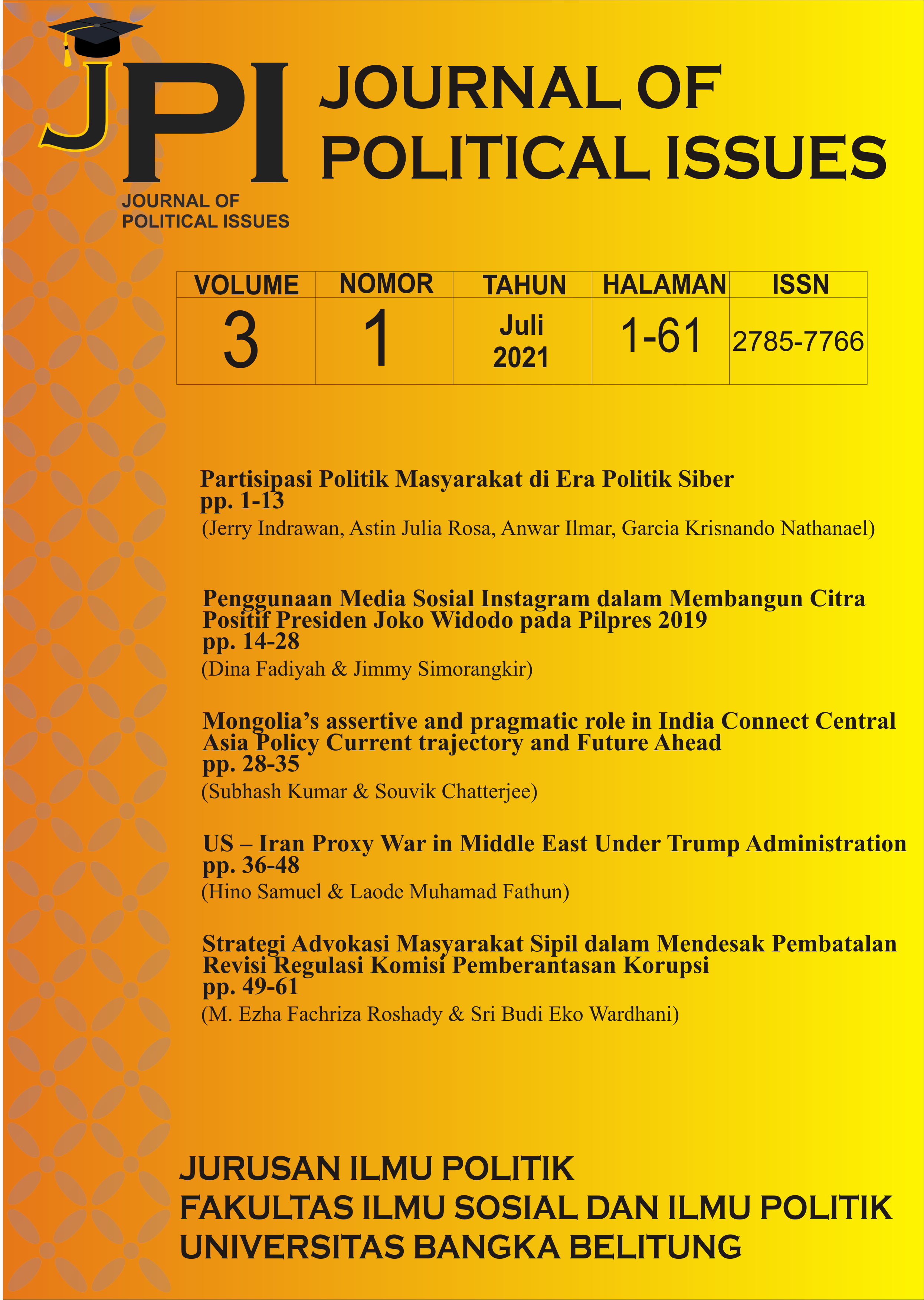US – Iran Proxy War in Middle East Under Trump Administration
Abstract
The heated bilateral relation between Iran and the United States has brought the middle east into another level of problem. The divided geopolitical and regional interest of both countries has led to several and many multidimensional issues, ranging from political, security, and even to economic ones. This article discussed the Iran – US tension on their proxy conflict in the Middle East. This article employs the Regional Security Complex Theory to construct the events related to both states’ proxy conflicts. The polarized region for sure has drawn another line that seems to be more complexed for both countries to achieve mutual understanding and continued peacebuilding. The US withdrawal from JCPOA, killing of Soleimani, and Saudi Arabia – Iran Yemen proxy war exacerbated the status quo. This article perceived that the intertwined issues show how the traditional thought of security should be redefined as both countries try to gain bargaining power. Especially with Iran that was hindered very much by sanctions and embargo placed by the US. This article discusses many important issues on Iran, US, and Saudi Arabia involvement and their correlated dynamics within the UN. This article analyzed Trump’s leadership style in the Middle East and its implication from the proxy war to the Middle East security architecture.
Downloads
References
Acharya, A. (2007). The Emerging Regional Architecture of World Politics. World Politics, 59(4), 629–652. https://doi.org/10.1353/wp.2008.0000
Ahmed, N. (2019). Yemeni Civil War: Causes, Consequences And Prospects. JDP (Jurnal Dinamika Pemerintahan), 2(2), 82–91. https://doi.org/10.36341/jdp.v2i2.943
Amnesty International. (2019). Review of human rights in the Middle East and North Africa. Retrieved July 8, 2021, from https://www.amnesty.org/en/latest/research/2019/02/human-rights-in-the-middle-east-and-north-africa-2018/
Asadi, T. (2015). On the Effectiveness of UN Security Council Sanctions: HSE Approach to the Case of Iran. Actual Problems of Economics: Scientific Economic Journal, 11(173), 21–31.
Baron, A., & Al-Hamdani, R. (2019, December 10). The “Proxy War” Prism on Yemen. New America. https://www.newamerica.org/international-security/reports/the-proxy-war-prism-on-yemen/
Bassist, R. (2021, March 29). Chances for Israeli alliance with Saudis against Iran fading. Al-Monitor: The Pulse of the Middle East. https://www.al-monitor.com/originals/2021/03/chances-israeli-alliance-saudis-against-iran-fading
Basundoro, A. F. (2020). Perang Proksi Kontemporer Arab Saudi-Iran Sebagai Bentuk Turbulensi Timur Tengah: Sebuah Analisis Geopolitik. Jurnal Penelitian Politik, 17(1), 1–16. https://doi.org/10.14203/jpp.v17i1.847
Bayoumy, Y. B. L., & Love, B. (2018, May 10). Europeans work to save Iran deal, and business, after Trump pulls out. U.S. https://www.reuters.com/article/us-iran-nuclear/europeans-work-to-save-iran-deal-and-business-after-trump-pulls-out-idUSKBN1I90D6
BBC News. (2018, May 9). Iran nuclear deal: Trump pulls US out in break with Europe allies. https://www.bbc.com/news/world-us-canada-44045957
Beck, M. (2019). US Middle East Policy Shift: Trump’s Administration Divergency. RUDN Journal of Public Administration, 6(4), 296–311. https://doi.org/10.22363/2312-8313-2019-6-4-296-311
Berti, B., & Guzansky, Y. (2014). Saudi Arabia’s Foreign Policy on Iran and the Proxy War in Syria: Toward a New Chapter? Israel Journal of Foreign Affairs, 8(3), 25–34. https://doi.org/10.1080/23739770.2014.11446600
Brzezinski, Z. (2016, February 10). From Hope to Audacity Appraising Obama’s Foreign Policy. Foreign Affairs. https://www.foreignaffairs.com/articles/2009-12-11/hope-audacity
Buzan, B., & Waever, O. (2003). Regions and Powers: The Structure of International Society. Cambridge: The Press Syndicate of the University of Cambridge.
Dadandish, P., & Kouzehgar, K. J. (2010). A Critical Study of Regional Security Complex Theory by Using the Security Environment of South Caucasus. Rahbord, 19(56), 73-107. https://www.sid.ir/en/Journal/ViewPaper.aspx?ID=188895
Dai, H. (2018, August 31). Middle Eastern Interventions in Africa: Tehran’s Extensive Soft Power. Middle East Forum. https://www.meforum.org/7254/middle-eastern-interventions-in-africa-tehran
Dunn, D. H. (2007). ‘Real men want to go to Tehran’: Bush, pre-emption and the Iranian nuclear challenge. International Affairs, 83(1), 19–38. https://doi.org/10.1111/j.1468-2346.2007.00601.x
Ekşi, M. (2017). Regional Hegemony Quests in the Middle East from the Balance of Power System to the Balance of Proxy Wars: Turkey as Balancing Power for the Iran - Saudi Rivalry. Gazi Akademik Bakış, 11(21), 133–156. https://doi.org/10.19060/gav.379597
El-Katiri, M. (2014). United States-Gulf Cooperation Council Security Cooperation in A Multipolar World. Carlisle: US Army War College Press. http://www.jstor.org/stable/resrep11893
el Khalfi, M. A. (2020). AGREEMENT ON THE JOINT COMPREHENSIVE PLAN OF ACTION (JCPOA) BETWEEN IRAN AND THE UNITED STATES. Jurnal Pembaharuan Hukum, 7(2), 183. https://doi.org/10.26532/jph.v7i2.11296
Grare, F. (2007). The Evolution of Sectarian Conflicts in Pakistan and the Ever-Changing Face of Islamic Violence. South Asia: Journal of South Asian Studies, 30(1), 127–143. https://doi.org/10.1080/00856400701264068
Hussain, N. (2015). US-Iran Relations: Issues, Challenges and Prospects. Policy Perspectives, 12(2), 29–47. https://doi.org/10.13169/polipers.12.2.0029
Kamrullah, M. R. N. (2017). Peran Jabhat Al-Nusra dalam Memberikan Tantangan terhadap Kebijakan Amerika Serikat Mendukung Kelompok Oposisi pada Konflik Bersenjata di Suriah. Global: Jurnal Politik Internasional, 19(2), 77. https://doi.org/10.7454/global.v19i2.287
Katzman, K., Mcinnis, K., & Thomas, C. (2020, May 8). U.S.-Iran Conflict and Implications for U.S. Policy. CRS Reports. https://www.everycrsreport.com/reports/R45795.html
Lee, L. (2020). The Yemen crisis and civil society: surviving the despite odds. Humanitarian Exchange, https://odihpn.org/magazine/yemen-crisis-civil-society/
Marsheimer, J. (2001). The Tragedy of Great Power Politics. New York: W. W. Norton.
Mirhosseini, S. M. (2014). Evolution of Dual Containment Policy (the Policy of Clinton’s Administration - Clinton’s Doctrine) in the Persian Gulf. Sociology and Anthropology, 2(3), 106–112. https://doi.org/10.13189/sa.2014.020305
Moin, B. (1999). Life of the Ayatollah. New York: Thomas Dunne Books.
Morgan, C. (2015). US - Iran Relations: A History of Covert Action and a Promising Future. The Cohen Journal, 2(1). Diambil kembali from https://digitalcommons.library.umaine.edu/tcj/vol2/iss1/1
Mumford, A. (2013). Proxy Warfare: War and Conflict in the Modern World. Cambridge: Polity Press.
Naghizadeh, M. (2019). Rivalry Through Proxies: How Iran and Saudi Arabia Compete For Regional Influence. St Antony's International Review, 137-153.
Nakhavali, M. (2013). Diplomatic, Consular and Political Relations Between Iran and United States. European Scientific Journal, 9(14), 49-63. https://eujournal.org/index.php/esj/article/view/1069/1103
Nuruzzaman, M. (2012). Conflicts between Iran and the Gulf Arab States: An Economic Evaluation. Strategic Analysis, 36(4), 542–553. https://doi.org/10.1080/09700161.2012.689512
Nye, J. (2010, June 14). East Asian Security: The Case for Deep Engagement. Foreign Affairs. https://www.foreignaffairs.com/articles/asia/1995-07-01/east-asian-security-case-deep-engagement
Qurtuby, S. A., & Aldamer, S. (2020). Terrorism and Counterterrorism in Saudi Arabia. Contemporary Review of the Middle East, 8(1), 56–76. https://doi.org/10.1177/2347798920976286
Rahman, M. (2020). CURRENT PHENOMENON TENSION OF THE UNITED STATES AND IRAN IN THE MIDDLE EAST. Journal of Islamic World and Politics, 4(1), 31–47. https://doi.org/10.18196/jiwp.4143
Ramsey, M. D. (2016). Evading the Treaty Power?: The Constitutionality of Nonbinding Agreements. FIU Law Review, 11(2). https://doi.org/10.25148/lawrev.11.2.9
Rauta, V. (2018). A structural-relational analysis of party dynamics in proxy wars. International Relations, 32(4), 449–467. https://doi.org/10.1177/0047117818802436
Roberts, D., & Borger, J. (2017, December 1). Obama holds historic phone call with Rouhani and hints at end to sanctions. The Guardian. https://www.theguardian.com/world/2013/sep/27/obama-phone-call-iranian-president-rouhani
Sauer, T. (2007). Coercive Diplomacy by the EU: The Case of Iran. The Hague: Netherlands Institute of International Relations 'Clingendael'.
Scott, C. V. (2000). Bound for Glory: The Hostage Crisis as Captivity Narrative in Iran. International Studies Quarterly, 44(1), 177–188. https://doi.org/10.1111/0020-8833.00153
Seymour, L. J. M. (2013). Let’s Bullshit! Arguing, Bargaining and Dissembling Over Darfur. SSRN Electronic Journal, 20(3). https://doi.org/10.2139/ssrn.2386522
Smith, J. B. (2016, January 5). Former U.S. Ambassador: What the Saudi Arabia-Iran Conflict Means for Stability. Time. https://time.com/4167026/saudi-arabia-iran-conflict-and-stability/
Steenkamp, C. (2017). The Crime-Conflict Nexus and the Civil War in Syria. Stability: International Journal of Security and Development, 6(1). https://doi.org/10.5334/sta.522
Totten, M. J. (2016). The New Arab–Israeli Alliance. World Affairs, 179(2), 28–36. https://doi.org/10.1177/0043820016673779
Trevithick, J. (2019, May 14). U.S. Government Claims Iran Is Behind Attacks On Oil Tankers, But Has Yet To Show Evidence. The Drive. https://www.thedrive.com/the-war-zone/27992/u-s-government-claims-iran-is-behind-attacks-on-oil-tankers-but-has-yet-to-show-evidence
Valerio Jovan, C. (2021). THE UNITED STATES UNILATERAL WITHDRAWAL FROM THE RESTRICTIONS OF IRAN’S NUCLEAR PROGRAM IN JCPOA 2015 UNDER INTERNATIONAL LAW. Padjadjaran Journal of International Law, 4(2), 247–264. https://doi.org/10.23920/pjil.v4i2.414
Wahyuni, S., & Baharuddin, S. S. (2017). The Impact of GCC Boycott on Qatar Foreign Policy. Jurnal Transformasi Global, 4(2), 80-89. https://transformasiglobal.ub.ac.id/index.php/trans/article/view/71
Walt, S. M. (1987). Origins of Alliance. Ithaca: Cornell University Press.
Wehrey, F. (2011). Uprisings Jolt the Saudi-Iranian Rivalry. Current History, 110(740), 352–357. https://doi.org/10.1525/curh.2011.110.740.352
Wintour, P. (2017, November 28). Qatar diplomatic crisis – what you need to know. The Guardian. https://www.theguardian.com/world/2017/jun/05/qatar-diplomatic-crisis-what-you-need-to-know
Yee, V. (2019, May 15). Yemen’s Houthi Rebels Attack Saudi Oil Facilities, Escalating Tensions in Gulf. The New York Times. https://www.nytimes.com/2019/05/14/world/middleeast/saudi-oil-attack.html
Yeganeh, H. (2011). The “Great Satan” talks with the “Evil.” International Journal of Conflict Management, 22(3), 219–238. https://doi.org/10.1108/10444061111152946
Copyright (c) 2021 Hino Samuel Jose, Laode Muhamad Fathun

This work is licensed under a Creative Commons Attribution-NonCommercial-ShareAlike 4.0 International License.
- Authors retain copyright and grant the journal right of first publication with the work simultaneously licensed under a Creative Commons Atribusi-Non Commercial-Share Alike (CC BY-NC-SA).
- Authors are able to enter into separate, additional contractual arrangements for the non-exclusive distribution of the journal's published version of the work (e.g., post it to an institutional repository or publish it in a book), with an acknowledgement of its initial publication in this journal.
- Every publication (printed/electronic) are open access for educational purposes, research, and library. Other than the aims mentioned above, the editorial board is not responsible for copyright violation.

















